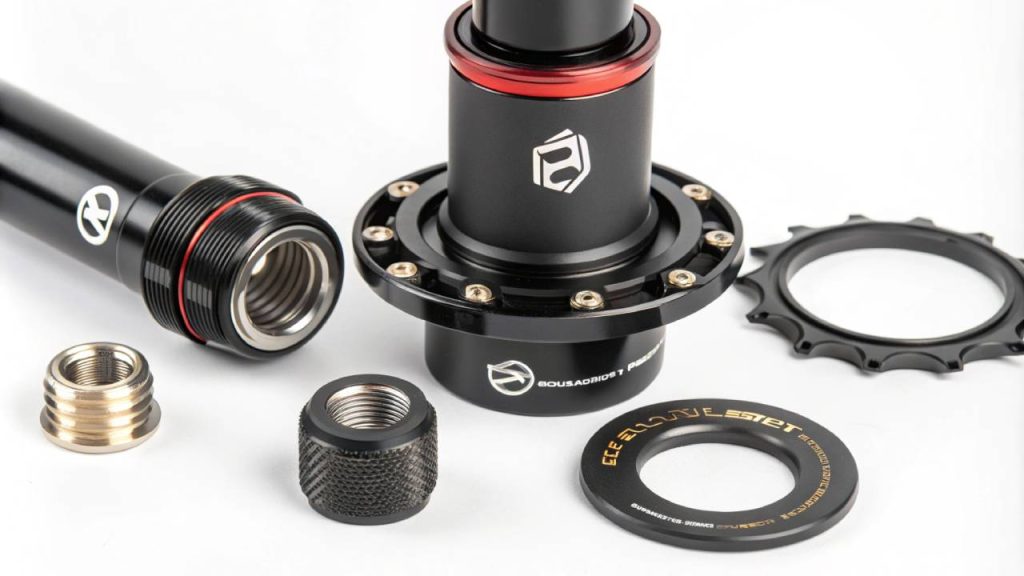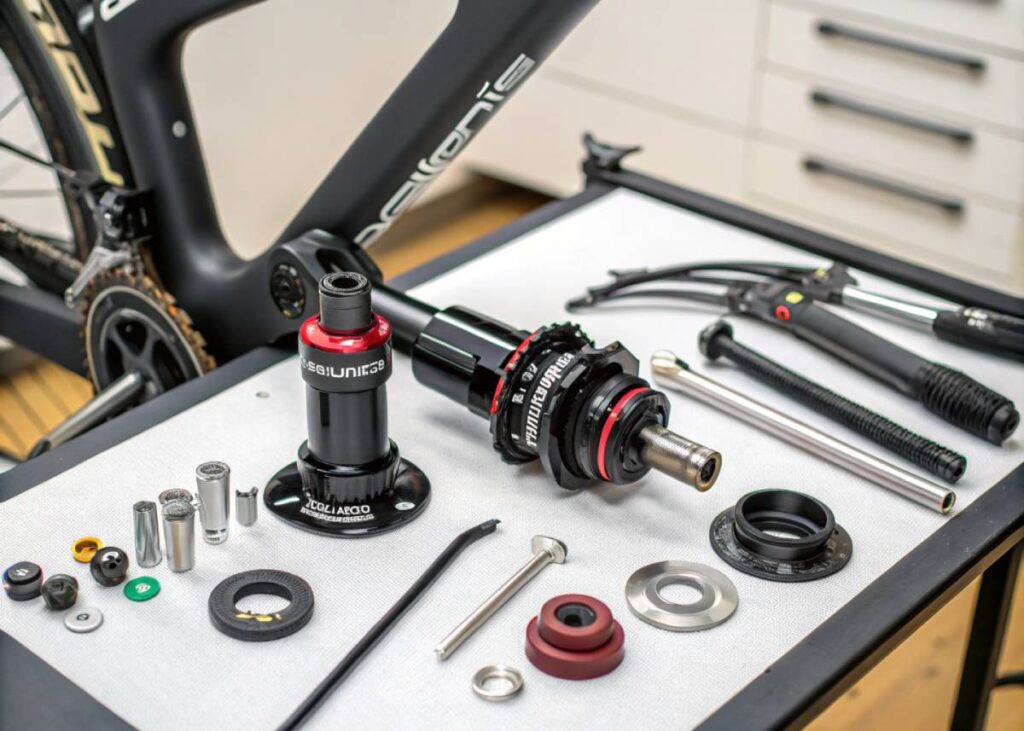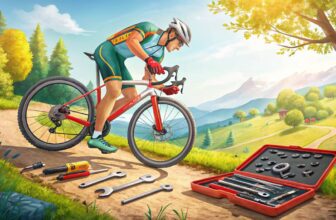Ever felt that your bike’s steering isn’t as smooth as it used to be? Don’t let a neglected headset turn your favorite ride into a frustrating ordeal. The bike headset may be small, but it’s the cornerstone of seamless steering and overall bike performance.
Whether you’re a seasoned cyclist or a weekend warrior, understanding and maintaining your headset can transform your riding experience from shaky to silky smooth.
Let’s dive into the easy steps to service your bike headset and keep your ride gliding effortlessly.
Understanding Bike Headsets
Got a ride you love? Don’t overlook the bike headset—it’s the unsung hero holding it all together. When handled properly, this little marvel keeps your steering silky and your biking smooth. It’s a must-know for anyone wanting their bike to glide like it’s meant to.
Function of a Bike Headset
Think of the headset as the handshake between your bike’s frame and wheels. Nestled in the head tube, it pulls off some pretty nifty tasks:
- It makes sure your handlebars are in cahoots with your front wheel for easy steering.
- Running on bearings brings you something magical: smooth rotation. So when you turn those handlebars, your wheel kindly follows suit without any fuss.
- It anchors the fork in place, preventing any wobble or unease, so you can keep riding, worry-free.
Mess up the headset, and you’re in for a bumpy, unpredictable journey—not fun! Remember, keeping up with bike bearing maintenance ain’t just for show—it’s for your ride’s longevity and safety, too.
Components of a Bike Headset
Alright, let’s break down the headset’s VIP club—these bits are crucial for your bike’s relentless charm. Get cozy with these parts, and you’ll handle servicing your bike headset like a pro:
| Component | What’s It Up To? |
|---|---|
| Head Tube | They’re the keepers, holding bearings snugly, and can be spotted inside or out. |
| Bearings | The unsung heroes provide stability by holding everything firm. |
| Fork Crown | A trusty connector for your fork and the headset’s lower section. |
| Cups | The unsung heroes provide stability by holding everything firm. |
| Top Cap and Bolt | The unsung heroes providing stability by holding everything firm. |
| Stem | It’s the bridge between your handlebars and fork’s steerer tube—simple yet vital. |
Heads up! The lower headset bearing often gets rusty a bit faster because the road loves to throw its dust and muck straight at it. Regular bike gear indexing and check-ups catch those gremlins early on.
Bottom line? Knowing your bike headset parts and giving ‘em some TLC isn’t just bike talk; it translates to smoother, safer rides. Wanna dive deeper into bike lingo and maintenance hocus-pocus? Skim through our bike repair guides for the full scoop!
Types of Bike Headsets
You don’t have time to fuss with complicated bike parts, right? Picking the right headset for your bike is a big deal, and you’ve got three main choices: threaded headsets, threadless headsets, and integrated headsets.
Threaded Headsets
Picture it like your grandpa’s favorite tool. Threaded headsets are the old-school choice with a threaded steerer tube held together by a locknut. The parts screw into place like a good ol’ DIY project.
Here’s what you gotta know:
- Adjustment: Think muscle work—grab those wrenches to make tweaks.
- Components: You’ve got the locknut, adjusting cup, and threaded steerer doing the dance.
- Common Sizes: Typically dance in sizes of 1 inch or 1 1/8 inch.
Threadless Headsets
Stepping up, threadless headsets, lovingly called AheadSet, kick the threaded ones to the curb with fancy tech. No threading here; it’s all about simplicity and style with tools like hex or Torx keys.
Quick rundown of the perks:
- Ease of Service: Less hassle; more straightforward than threading a needle.
- Adjustment: Tighten it up with the top cap before clamping down the stem. Easy peasy.
- Components: Get it all locked down with a clamping stem and top cap pressure.
Sizes: You’ll spot these at 1 inch, 1 1/8 inch, and occasionally neck-stretching diameters for those specialty rides.
| Feature | Threaded | Threadless |
|---|---|---|
| Ease of Adjustment | Requires wrenches | Uses hex or Torx keys |
| Steerer Tube | Threaded | Smooth |
| Preloading | Not applicable | Uses top cap |
| Common Usage | Rocking older bikes | Strutting on modern rides |
“Choosing the right headset is crucial for optimal bike performance. It directly affects how your bike handles and responds on the road or trail.”
— Jane Doe, Professional Mountain Biker
Integrated Headsets
Now, integrated headsets are the sleek, modern option for high-class rides. Bearings pop right into the frame’s head tube like magic.
Need-to-know Bits:
- Design: The bearings are home in the frame—no jig-saw puzzle with press-in cups needed.
- Maintenance: Frying it down to simplicity; fewer parts, less chaos.
- Applications: Frequent flyers on high-end road and mountain bikes.
| Type | Adjustment Tools | Components | Common Usage |
|---|---|---|---|
| Threaded | Wrenches | Locknut, cups | Old-school bikes |
| Threadless | Hex/Torx keys | Top cap, stem | Hip, modern bikes |
| Integrated | Minimal tools | Bearings, frame | Top-notch rides |
Choosing the right headset gives your bike the vroom it needs to shine and makes the maintenance headache go away. Whether you’re spinning through a bike maintenance routine or solving weird bike noise issues, knowing these types will help you make the perfect choice.
Check out more cool tips on keeping that headset smooth in our bike bearing care guide and other nifty bike repair tips.
Standard Headset Information System (SHIS)
Sorting out bike headsets can feel like assembling a jigsaw puzzle. That’s where the Standard Headset Information System, or SHIS, jumps in to save the day. This system makes it easier to figure out the different headset types that fit your ride.
Introduction to SHIS
The SHIS was created to sort through the confusion of headset standards on bikes. Think of it as a secret decoder ring for cyclists; it helps everyone speak the same language when talking about headsets. After all, with so many types and sizes, it’s no wonder folks feel lost sometimes.
Headsets are like the unsung heroes of your bike, holding the magic behind the steering and keeping your fork stable. They’re perched right between the fork’s crown and the bike’s head tube. These parts are the glue that keeps things turning smoothly.
SHIS Classification Codes
In the world of SHIS, letters and numbers team up to pinpoint headset types and sizes. The letters tell you what kind of headset it is, while the numbers reveal the head tube bore diameter in millimeters.
Here’s the rundown on the main SHIS codes:
- EC – External Cup: The bearings are secure in cups that hang outside the head tube.
- ZS – Zero Stack/Internal Headset: These guys cozy up inside cups nestled deeper into the head tube.
- IS – Integrated: Bearings here are snug right into the head tube, skipping the cups altogether.
Your quick reference table for SHIS looks like this:
| SHIS Code | Description | Example Size |
|---|---|---|
| EC (External Cup) | Bearings in external cups | EC34 |
| ZS (Zero Stack) | Bearings in recessed cups | ZS44 |
| IS (Integrated) | Bearings integrated into head tube | IS41 |
Sources: Bike Radar, Funn MTB
With SHIS, matching measurements to your bike’s frame and fork becomes child’s play—well, almost. Always peek at the manufacturer’s notes to make sure you’re nabbing the right headset model.
For tips on keeping your two-wheeler in mint condition, swing by our posts on a bike maintenance schedule, cleaning a bike chain, and bike tool kit essentials.
Grasping SHIS can be a game-changer when installing or giving your bike headset the TLC it deserves. Hop on over to our bike repair guides for a treasure trove of tips and tricks.
Factors to Consider When Choosing a Headset
Picking out the perfect headset for your bike is like finding the right pair of shoes – it has to fit just right. A good headset keeps your rides smooth and helps your bike last longer. Here’s what you should look out for when you’re in the market for one:

Quality of Bearings
The magic behind your bike’s smooth feel is all in the bearings. You want to go with top-notch bearings that won’t buckle under pressure and will keep rolling like new for a long time. There are two main types to consider:
- Angular Contact Bearings: These are the heavy hitters when it comes to front-end bike gear. They can take on forces head-on and sideways, perfect for the wild rides we love today.
- Ball Bearings: Old school as they come, but these classics get the job done. They’re the go-to for those who like to tweak and fine-tune their rides. If you’re into a bit of DIY maintenance, these guys let you play around with the tension for just the right feel.
Sealing and Durability
Nobody likes grime getting all up in their gears. The sealing on a headset keeps the yucky stuff out, saving your bearings from a slow and painful demise.
- Cartridge Bearings: The strong, silent type of bearings. Their sealed nature means they’re low-maintenance and easy to switch out when the time comes, making them a favorite in threadless headsets.
- Caged Ball Bearings: You’ll often spot these in bikes that are easier on the wallet. They need a bit more tender loving care but won’t break the bank.
“Investing in high-quality bearings and durable components can significantly enhance your riding experience, offering both safety and longevity.”
— John Smith, Cycling Gear Expert
Weight Considerations
For those bikers out there chasing that perfect ride, shedding a few grams can feel like dropping a weight class. Light headsets can make a world of difference without sacrificing the toughness you need.
| Bearing Type | Weight Consideration | Where You’ll Find Them |
|---|---|---|
| Angular Contact Bearings | Not too heavy, just right | High-octane rides |
| Ball Bearings | Holds onto a bit more weight | Classic builds |
| Cartridge Bearings | Heavy set and sturdy | Must have for easy maintenance |
When picking a headset, think about how it fits into your biking lifestyle. From quality and sealing to how much it weighs, these factors will point you in the right direction. Keep your bike in top shape by sticking to regular tune-ups and grabbing the right tools for the job. Check out our guides, they are chock-full of tips on keeping your bike bearings running smooth as butter.
Installing and Servicing Your Bike Headset
Keeping your bike headset in tip-top shape is a no-brainer for smooth steering and killer performance. Here’s the lowdown on the tools you’ll need, some handy tips, and an easy-peasy guide to swapping out those bearings.
Tools Required for Installation
Got a bike tool kit? If not, you definitely need one. Here’s the roll call for what you’ll need to mess with your bike headset:
- Headset Press
- Allen Wrench Set
- Torque Wrench
- Grease
- Crown Race Setter
- Bearing Cup Remover
- Headset Adjustment Thingamajig
- Clean Rags (because messy hands are a no-go)
Cleaning and Maintenance Tips
Want your headset to stay in the game? Give it some TLC with these tips:
- Peek Under the Hood: Spot any hiccups or odd sounds? Check for wear or grinding.
- Clean Up Job: Use a rag to wipe down the bearings and all the nooks and crannies.
- Grease It Up: A dab of grease on those bearings is gold – helps things spin nice and keeps the rust monsters at bay. For grease love, hop over to our best bike lubricants.
- Keep the Dirt Out: Seals snugly in place? Good. They keep the muck and water out.
- Check-Ups: Even when it ain’t broke, give it a look-see every now and then. Swing by our bike maintenance schedule for more.
Replacing Headset Bearings
Nothing lasts forever, not even bearings. Here’s how to get back that buttery-smooth steer:
1. Off with the Fork and Stem:
- Grab your Allen wrench to loosen stem bolts.
- Pop off the top cap and ease the stem from the fork steerer.
- Gently wiggle the fork free from the head tube.
2. Out with the Old Bearings:
- Use the bearing cup remover to get those crusty old bearings out.
- Give the head tube a good clean and pat it down like it deserves.
3. In with the New Bearings:
- Smear some grease inside the bearing cups or head tube (check our pals at BikeRadar).
- Nestle the new bearings in place, nice and snug.
4. Back with the Fork and Stem:
- Slide the fork back home and reattach the stem.
- Refit the top cap and tighten gently with an Allen wrench to make sure there are no wiggly bits.
5. Tweak Till It’s Smooth:
- Make adjustments for a perfect fit by tinkering with the top cap bolt BikeRadar.
- Ensure it steers like a dream but with zero slack.
For more kick-butt tips to keep your bike rocking, dig into our bike repair guides. A well-kept headset equals slick steering and a sweeter ride.
While you’re at it, check out other useful stuff we’ve got on adjusting bike brakes and cleaning bike chains. Happy riding!
Adjusting Your Bike Headset
Getting your bike headset just right is crucial for those smooth, dreamy rides where you’re more worried about which snack to eat next rather than staying safe. Let’s chat about how to tweak your headset without making a mess of things!
Fine-Tuning the Headset
Tweaking your headset is all about finding that sweet spot where there’s no wibble-wobble and your steering feels like butter. Got a threaded headset? Time to get friendly with that locknut and lower cup. A teeny weeny eighth of a turn usually does the trick.
If you’re rocking a threadless headset, pat yourself on the back. It’s simpler and you’ll just need a hex or Torx key. Here’s your step-by-step:
- Loosen the stem bolts: Grab a hex key and loosen those bolts that are holding the stem to the fork steerer tube.
- Tweak the top cap: Tighten the top cap bolt gently until you hit a modest resistance. This sorts out the bearings.
- Check it out: Pull the front brake, and jiggle the bike a bit. Feeling any slack? Tighten the top cap bolt little by little.
- Line up the handlebars: Keep it straight, champ! Make sure the handlebars and front wheel are best buddies.
- Re-tighten the stem bolts: Secure those bolts nice and firm like you’re locking away your secret cookie stash.
Addressing Common Issues
Let’s get into some typical headset gremlins that might crop up like unwanted ads, and how you can shoo them away:
1. Loose Headset:
- Why it happens: That top cap or locknut might be slacking off.
- The fix: Give the top cap bolt a bit of love on threadless headsets or tighten the locknut for the threaded ones.
2. Stiff Headset:
- Why it happens: Someone’s been heavy-handed on the top cap or the bearings missed their lube bath.
- The fix: Ease up the top cap or locknut slightly. Say hi to the lubricant and give your bearings what they deserve.
3. Weird Noises:
- Why it happens: Nasty dirt hiding in the bearings or some loose bits.
- The fix: Shower those bearings with grease and tighten every bit to specification. For more head-tinkering tips, look at bike bearing maintenance.
4. Wonky Alignment:
- Why it happens: A squiffy stem or bearings doing their own thing.
- The fix: Get those handlebars in line with the wheel. Check that the bearings are sitting pretty in their races. Our bike safety check guide is there for extra coziness.
Keep your bike feeling fresh with some regular TLC. If you need to know what other gadgets you might need, pop into our bike tool kit essentials.
By keeping things on point and fixing what needs fixing, those fairytale rides will keep rolling. For more wisdom on bike sprucing, including brake tweaking or fixing bottom brackets, get stuck into our bike repair guides.
Upgrading Your Bike Headset
Thinking of sprucing up your ride with a headset upgrade? If you’re a cycling fanatic or just love taking on tricky trails, this guide might just be for you. Let’s take a closer peek at some specialized headsets and why upgrading will have you smiling like a kid in a candy store.

Special Purpose Headsets
Some headsets are built to meet certain riding needs, giving you a boost in performance.
AngleSet by Cane Creek
Take the AngleSet from Cane Creek, for example. This gizmo lets you tweak your bike’s head angle, adjusting the steerer tube in the head tube by up to 2 degrees. What’s that do, you ask? It changes how your bike handles without messing up other parts like the seat angle or bottom-bracket height. Perfect for mountain bikers who want to fine-tune their ride’s responsiveness.
Descend Headset by Funn MTB
The Descend headset by Funn MTB is another top choice. It’s got these angular contact bearings that deal with gnarly, complex loads while staying easy to maintain. Smooth rotation? Check. Built tough for rowdy riding? Double-check.
Benefits of Upgrading
So, why should you bother swapping out your old headset for a shiny new one? Here’s a quick rundown of the perks:
- Better Handling and Stability
An upgraded headset might just be the ticket to shaving seconds off your ride time. Adjustable headsets (looking at you, AngleSet) let you dial in handling, making technical terrain less of a white-knuckle ride. - Tougher and Lasts Longer
Top-tier headsets come loaded with quality bearings designed to take a beating and keep on rolling. They’re durable, cutting down on wear and tear, so your bike can brave the bumps and bruises of regular rides. - Less Fuss, More Riding
Advanced headsets often include clever sealing tech to fight off dirt and grime. That means less time fixing and more time riding. Curious about keeping your headset in tip-top shape? Check out our bike bearing maintenance. - Cozy Rides Ahead
Who wouldn’t want a smoother ride? With a primo headset, you’ll soak up those pesky vibrations and shocks. It’s a game-changer for marathon riders and those who tango with bumpy paths.
Taking the leap and upgrading your headset could just open the door to a whole new cycling adventure. Want more tips on keeping your bike in prime condition? Browse our bike repair guides and see what you find.
Here’s a simple chart comparing the headsets we’ve mentioned:
| Headset Model | Adjustable Angles | Bearings Type | Neat Feature |
|---|---|---|---|
| AngleSet | Up to 2 degrees | Standard Bearings | Tweaks head angle for better handling |
| Descend | Not adjustable | Angular Contact | Handles tough loads while staying user-friendly |
Craving more maintenance advice? Have a look at our articles on cleaning your bike chain and tweaking your bike brakes. Remember, keeping your bike in shape doesn’t have to be a headache; a headset upgrade can mean more fun, fewer bumps, and limitless adventures.
Popular Bike Headset Brands
Picking a headset for your bike can feel like picking candy off a shelf, but don’t worry, we’ve done the taste-testing for you. Some top-notch brands have made a name for themselves by making stuff that just works, no matter if you’re a no-nonsense commuter or that daredevil on the weekend trails. So, let’s saddle up and check out some favorites among cycling fans!
Trek
Trek ain’t just a name slapped on a bike—it’s a ticket to durability town. Loved by the fast and the leisurely, Trek headsets seem to whisper, “Come rain, come shine; I’m here to make your ride memorable.” Whether you’re dodging traffic on your way to work or charging through dirt trails, Trek’s got the headsets to keep your wheels on the ground.
Canyon
If you’re looking for smooth sailing, Canyon could be your trusty ship. This brand is all about precision—smooth steering that even newbies and e-bike aficionados appreciate. It’s like that reliable friend who’s always on time and never lets you down. Canyon headsets are crafted to stick around, adding peace of mind to every twist and turn.
Santa Cruz
Think rugged rides through rocky terrains and Santa Cruz pops up. Known for gear that takes a licking and keeps on ticking, their headsets are no exception. Perfect for those who see a mountain and think, “Challenge accepted,” Santa Cruz ensures that your bike handles like a dream even when the ride gets wild.
Cervélo
Cervélo’s headsets aren’t just components—they’re about a buttery smooth ride. Imagine slicing through the air with control and precision; that’s what these bad boys are all about. Ideal for competitive cyclists wanting that edge, Cervélo headsets take your bike’s performance from cool to ice cold.
Giant
Giant is practically the friendly neighborhood bike brand. Known around the world, their headsets are like that trusty old friend who’s always got your back. Commuters and speed-chasers love them for their smooth steering and long-lasting vibes. When reliability is on your checklist, Giant’s a great tick in the box.
If you want to keep your bike headset as fresh as a daisy, don’t skip your bike maintenance routine. Understanding bike bearing care is another step to keep things spinning without a hitch. And check out our bike repair tips for more ways to spoil your two-wheeled buddy.
Conclusion
Maintaining your bike headset is essential for ensuring smooth steering, enhanced performance, and the longevity of your bike. From understanding the different types and components to selecting the right headset and performing regular maintenance, each step plays a crucial role in your cycling experience.
Upgrading your headset can offer better handling, increased durability, and a more comfortable ride while choosing quality accessories ensures safety and efficiency on every journey.
Remember, a well-serviced headset not only keeps your bike in top shape but also elevates every ride you take. So, gear up, follow these steps, and enjoy the seamless adventures ahead!
FAQs
What is a bike headset and why is it important?
A bike headset connects the bike’s frame to the fork, allowing for smooth steering and stability. Proper maintenance ensures safe and efficient rides.
How often should I service my bike headset?
It’s recommended to check your headset every few months or after extensive rides. Regular maintenance can prevent issues and extend the headset’s lifespan.
What tools do I need to service my bike headset?
Essential tools include a headset press, Allen wrench set, torque wrench, grease, crown race setter, bearing cup remover, and clean rags.
Can I upgrade my bike headset for better performance?
Yes, upgrading to higher-quality headsets can improve handling, durability, and ride comfort. Specialized headsets like AngleSet and Descend offer enhanced features.
What are the signs that my bike headset needs servicing?
Common signs include loose steering, unusual noises, stiff movement, and wobbling. Addressing these issues promptly ensures a safe riding experience.




